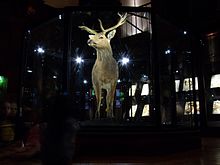- Schomburgk's Deer
-
Schomburgk's Deer 
Specimen in West Berlin Zoo Conservation status Scientific classification Kingdom: Animalia Phylum: Chordata Class: Mammalia Order: Artiodactyla Family: Cervidae Subfamily: Cervinae Genus: Rucervus Species: †R. schomburgki Binomial name †Rucervus schomburgki
Blyth, 1863Schomburgk's Deer (Rucervus schomburgki) was a member of the family Cervidae. This deer was endemic to Thailand. Schomburgk's deer was described by Edward Blyth in 1863 and named after Sir Robert H. Schomburgk, who was the British consul in Bangkok from 1857-1864.[2]
This deer was a graceful species similar in appearance to the barasingha.[2] The fur was a dark brown with lighter underparts.[2] The underside of the tail was white.[2] Males possessed basketlike antlers, upon which all the main tines branched.[2] This caused the deer to have up to 33 points on their antlers and the outer edge of the rack to be up to 35 inches long.[2] Females had no antlers.
Schomburgk's deer inhabited swampy plains with long grass, cane, and shrubs in central Thailand, particularly in the Chao Phraya River valley near Bangkok.[2] This deer avoided dense vegetation. They lived in herds that consisted of a single adult male, a few females, and their young.[2] However, during the flooding that occurred during the rainy season, the herds were forced together upon higher pieces of land which could turn into islands.[2] This made them easy targets for hunters.[2]
Commercial production of rice for export began in the late nineteenth century in Thailand leading to the loss of nearly all grassland and swamp areas this deer depended on. Intensive hunting pressure at the turn of the century restricted the species further until it became extinct.[3]
The wild population of Schomburgk’s deer is thought to have died because of overhunting in 1932, with the last captive individual being killed in 1938.[2] The species is also listed as extinct in the 2006 IUCN Red List of Threatened Species.[3] However, some scientists consider this species to be still extant.[4] Only one mounted specimen is known to be in existence, which currently resides in Paris's Muséum national d'Histoire naturelle after living in the zoo there until 1868.[2]
In 1991, antlers were discovered in a Chinese medicine shop in Laos. Laurent Chazée, an agronomist with the United Nations, later identified the antlers from a photograph he took as coming from Schomburgk's deer.[5]
External links
- The Extinction Website - Species Info - Schomburgk's Deer
- IUCN Red List of Threatened Species: Cervus schomburgki
See also
References
- ^ Duckworth, J.W., Robichaud, W.G. & Timmins, R.J. (2008). Rucervus schomburgki. In: IUCN 2008. IUCN Red List of Threatened Species. Downloaded on 7 January 2009.
- ^ a b c d e f g h i j k l Ellis, Richard (2004). No Turning Back: The Life and Death of Animal Species. New York: Harper Perennial. pp. 311–312. ISBN 0-06-055804-0.
- ^ a b World Conservation Monitoring Centre 1996. Cervus schomburgki. In: IUCN 2004. 2004 IUCN Red List of Threatened Species. <www.iucnredlist.org>. Downloaded on 22 April 2006. [1]
- ^ MacPhee, R.D.E. and Flemming, C. 1999. Requiem Æternam. The last five hundred years of mammalian species extinctions. In: R.D.E. MacPhee (ed.) Extinctions in Near Time, pp.333-371. Kluwer Academic/Plenum Publishers, New York.
- ^ Schoering, W.B., 1995. Swamp Deer resurfaces. Wildlife Conservation, vol 98, December, p22.
Categories:- IUCN Red List extinct species
- Mammals of Asia
- Mammals of Southeast Asia
- Mammals of Laos
- Mammals of Thailand
- Extinct mammals of Asia
- Extinct mammals
- Megafauna of Eurasia
- Mammal extinctions since 1500
- Cervines
- Species made extinct by human activities
Wikimedia Foundation. 2010.



